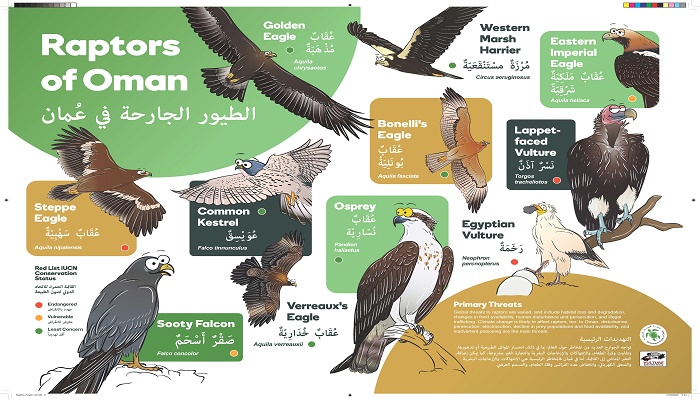
Muscat: Continuing its efforts to raise awareness on the Sultanate’s unique environmental heritage, the Environment Society of Oman (ESO) has released a new booklet, ‘Raptors of Oman’.
Available online for free, the booklet offers an introduction to the various raptors, or birds of prey, found in Oman, their diet, status and ways to identify them.
Written in both English and Arabic, it includes fun illustrations to appeal to children, too. Made possible with proceeds from the ‘Wild Oman’ art exhibition by Violet Astor, this booklet is part of ESO’s efforts to engage the public and bolster Oman’s conservation commitment to the important raptors that live here seasonally or year-round.
Maïa Sarrouf Willson, Research & Conservation Manager at ESO, said, “The Sultanate is a stronghold for a number of raptors whose declining populations are a cause for concern, several of which are listed as endangered or vulnerable on the International Union for Conservation of Nature (IUCN) Red List of Threatened Species. Our research work continues to focus on ensuring their survival and resources like this booklet are important ways to transmit knowledge and love for these magnificent birds, and ultimately, contribute to their conservation. We have collaborated with the IUCN Vulture Specialist Group to ensure it reaches a wider and diversified audience”.
Contributor Dr. Michael McGrady, Director of International Avian Research, added, “Global threats to raptors are varied, and include habitat loss and degradation, changes in food availability, human disturbance and persecution, and illegal trafficking. Climate change is likely to affect raptors, too.
“In Oman, disturbance, persecution, electrocution, decline in prey populations and food availability, and inadvertent poisoning are the main threats. As they play a key role in the eco-system, the protection of these species is not only important to Oman, but to the rest of the world.”
Around 39 species of raptors occur in Oman, either as residents or visitors, including the Egyptian Vulture, the Steppe Eagle, the Lappet-faced Vulture, the Saker Falcon, the Sooty Falcon, the Eastern Imperial Eagle and the Greater Spotted Eagle. 11 species are featured in detail in the booklet, with photos and illustrations. The other 28 species are listed in a table format along with their status in Oman and their IUCN conservation status. The booklet is part of a wider campaign from ESO, which includes field surveys, satellite tracking and outreach activities. A panel discussion with prominent raptor experts was organised online to launch the booklet.
To view the 40-page booklet along with a downloadable poster, visit http://eso.org.om/UserFiles/files/Raptors Booklet_Online.pdf